1994 CADILLAC FLEETWOOD maintenance
[x] Cancel search: maintenancePage 50 of 398
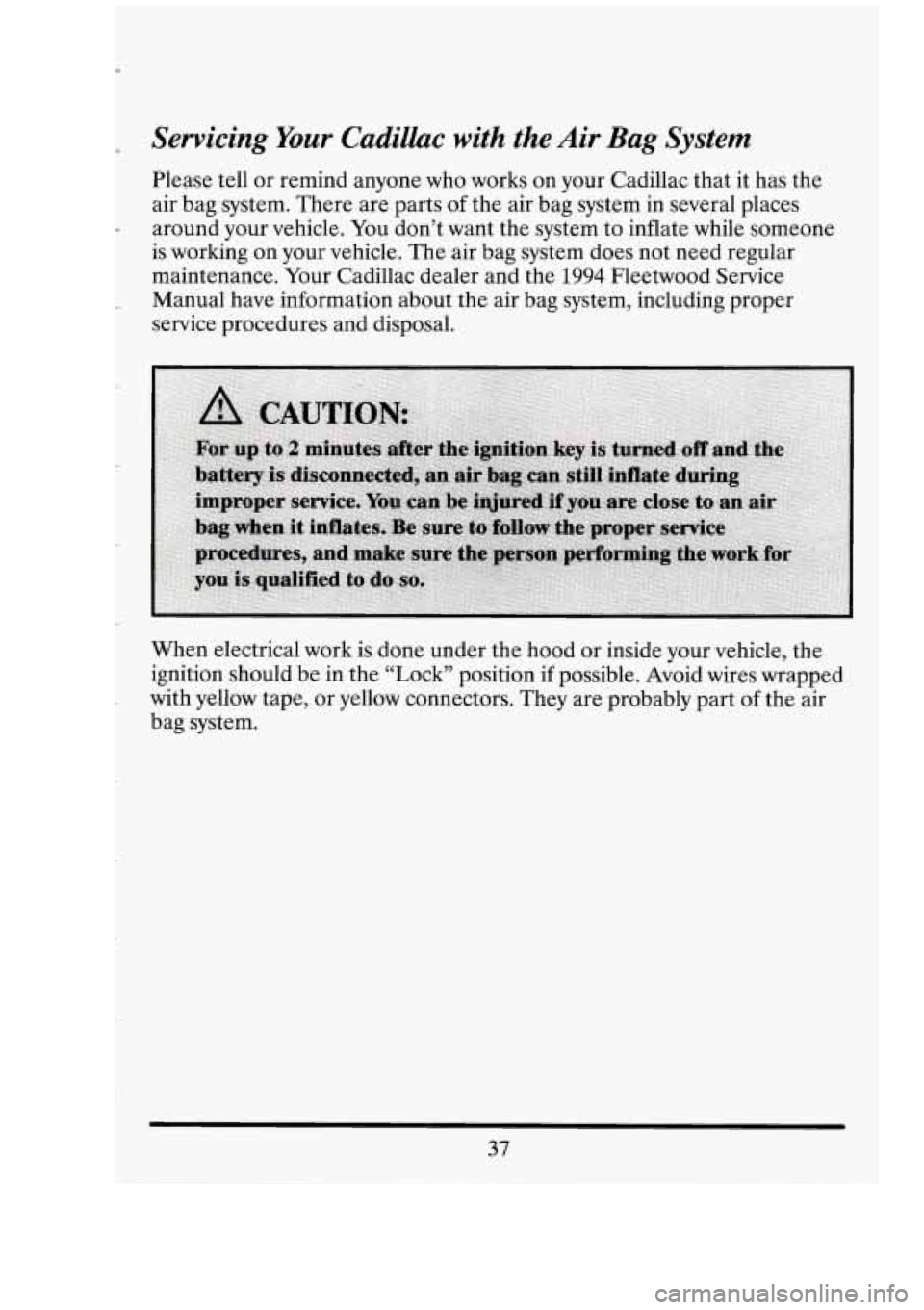
r Servicing Your Cadillac with the Air Bag System
Please tell or remind anyone who works on your Cadillac that it has the
air bag system. There are parts of the air bag system
in several places
around your vehicle. You don’t want the system to inflate while someone
is working on your vehicle. The air bag system does not need regular
maintenance. Your Cadillac dealer and the
1994 Fleetwood Service
Manual have information about the air bag system, including proper
service procedures and disposal.
When electrical work is done under the hood or inside your vehicle, the
ignition should be in the “Lock’’ position
if possible. Avoid wires wrapped
with yellow tape, or yellow connectors. They are probably part
of the air
bag system.
37
Page 158 of 398

OIL LIFE INDICATOR
Your Cadillac has an Oil Life Indicator feature. This tells you when
you need to change your engine oil. It’s based upon the engine oil
temperatures and your driving patterns.
Your Oil Life Indicator may say to change the oil sooner than your
maintenance schedule. This can happen if driving conditions, such as
short trips in cold weather, cause shorter
oil life. Always keep a written
record of the mileage and date when you last changed your oil. For more
information on when to change your oil, see the Cadillac Maintenance
Schedule Booklet.
The system probably will say to change the oil between
3000 miles
(5000 km) and 7500 miles (12500 km), but it may even say to change it
before
3000 miles under severe conditions. It all depends on your driving
patterns. (If it doesn’t, or if it doesn’t even light up, then something is
wrong. You will need to have it serviced.)
There are
two things the system won’t do: It can’t sense heavy dust in the
places where you drive.
If you drive in a dusty area, you should change
your oil every
3000 miles (5000 km) or 3 months (whichever comes first),
unless the “CHANGE OIC’ light comes on sooner.
It doesn’t check how much oil you have
so you will still have to check for
that.
To check it, see the Index under “Engine Oil.”
When You’ve Changed the Oil
When new oil is put in, you’ll need to reset your system. To do that, turn
the ignition switch to the
“ON” position with the engine stopped. Fully
depress and release the accelerator pedal
3 times within 5 seconds.
If the “CHANGE OIC’ light comes on and stays on for 5 seconds, it did
not reset. You’ll need to reset the system again.
145
Page 224 of 398
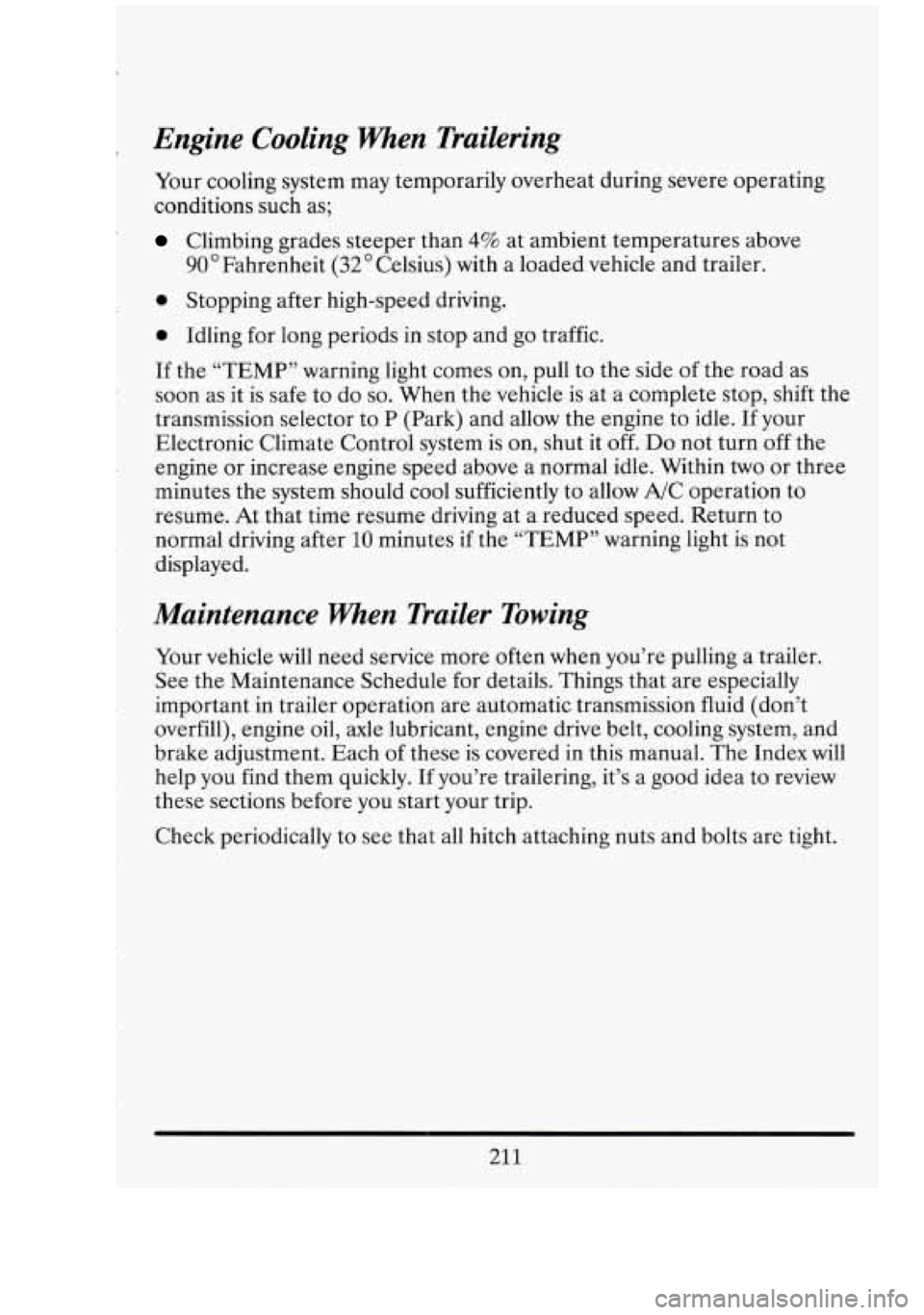
Engine Cooling When Trailering
Your cooling system may temporarily overheat during severe operating
conditions such as;
Climbing grades steeper than 4% at ambient temperatures above
90’Fahrenheit (32O Celsius)
with a loaded vehicle and trailer.
0 Stopping after high-speed driving.
0 Idling for long periods in stop and go traffic.
If the “TEMP” warning light comes on, pull
to the side of the road as
soon as it is safe to do
so. When the vehicle is at a complete stop, shift the
transmission selector to P (Park) and allow the engine to idle. If your
Electronic Climate Control system is on, shut it
off. Do not turn off the
engine or increase engine speed above a normal idle. Within
two or three
minutes the system should cool sufficiently to allow A/C operation to
resume. At that time resume driving at a reduced speed. Return to
normal driving after
10 minutes if the “TEMP” warning light is not
displayed.
Maintenance when Trailer Towing
Your vehicle will need service more often when you’re pulling a trailer.
See the Maintenance Schedule for details. Things that are especially
important in trailer operation are automatic transmission fluid (don’t
overfill), engine oil, axle lubricant, engine drive belt, cooling system, and
brake adjustment. Each of these is covered in this manual. The Index will
help you find them quickly. If you’re trailering, it’s a good idea to review
these sections before you start your trip.
Check periodically to
see that all hitch attaching nuts and bolts are tight.
21
1
Page 258 of 398
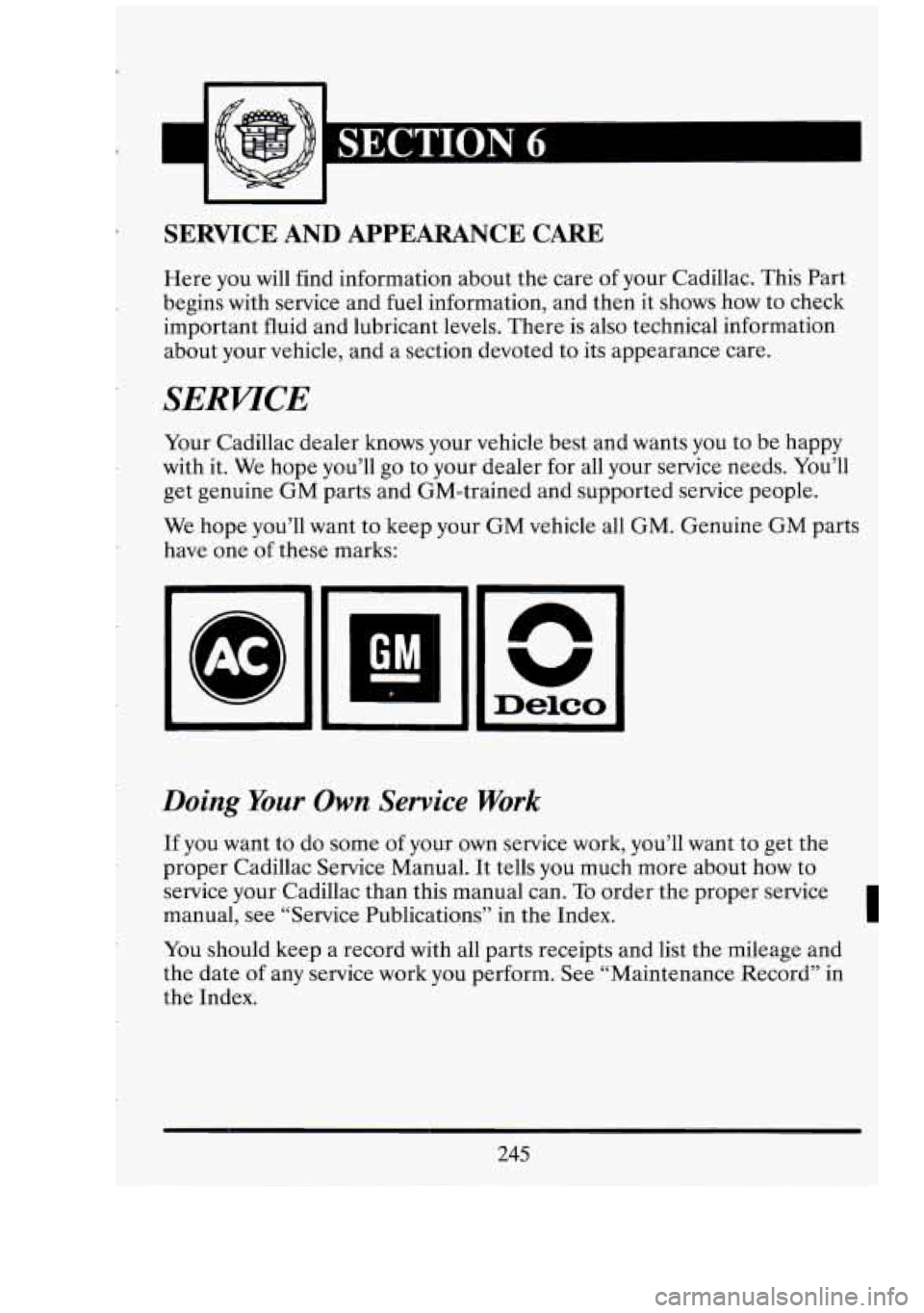
SERVICE AND APPEARANCE CARE
Here you will find information about the care of your Cadillac. This Part
begins with service and fuel information, and then
it shows how to check
important fluid and lubricant levels. There
is also technical information
about your vehicle, and a section devoted to
its appearance care.
SERVICE
Your Cadillac dealer knows your vehicle best and wants you to be happy
with it. We hope you’ll go to your dealer for all your service needs. You’ll
get genuine
GM parts and GM-trained and supported service people.
We hope you’ll want to keep your GM vehicle all GM. Genuine GM parts
have one
of these marks:
Doing Your Own Service Work
If you want to do some of your own service work, you’ll want to get the
proper Cadillac Service Manual. It tells you much more about how to
service your Cadillac than this manual can.
To order the proper service
manual, see “Service Publications”
in the Index. I
You should keep a record with all parts receipts and list the mileage and
the date
of any service work you perform. See “Maintenance Record” in
the Index.
245
Page 263 of 398
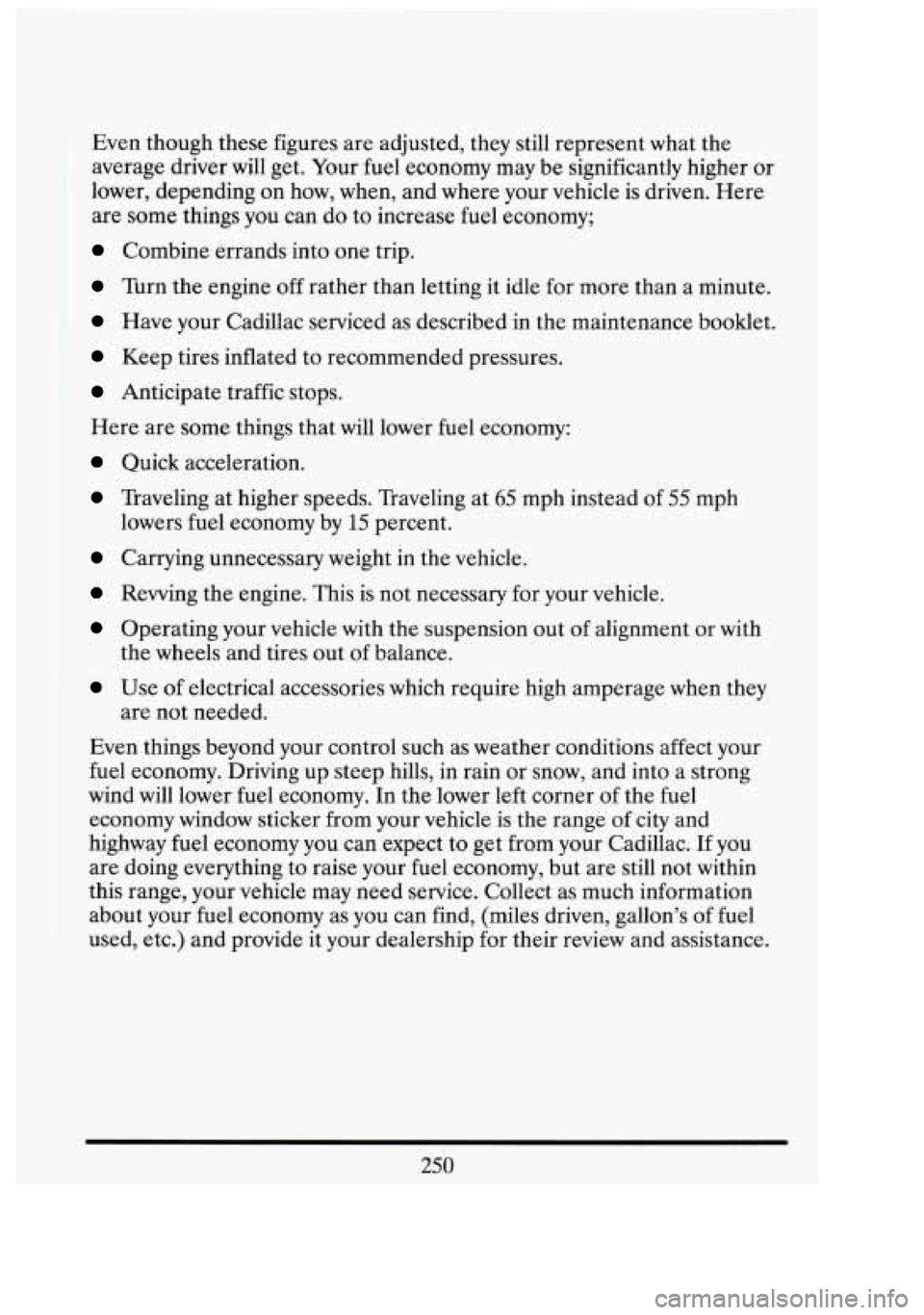
Even though these figures are adjusted, they still represent what the
average driver will get. Your
fuel economy may be significantly higher or
lower, depending on how, when, and where your vehicle is driven. Here
are some things you can do to increase fuel economy;
Combine errands into one trip.
Turn the engine off rather than letting it idle for more than a minute.
Have your Cadillac serviced as described in the maintenance booklet.
Keep tires inflated to recommended pressures.
Anticipate traffic stops.
Here are some things that will lower fuel economy:
Quick acceleration.
Traveling at higher speeds. Traveling at 65 mph instead of 55 mph
Carrying unnecessary weight in the vehicle.
lowers fuel economy
by
15 percent.
Rewing the engine. This is not necessary for your vehicle.
Operating your vehicle with the suspension out of alignment or with
the wheels and tires out
of balance.
Use of electrical accessories which require high amperage when they
are not needed.
Even things beyond your control such as weather conditions affect your
fuel economy. Driving up steep hills, in rain or snow, and into a strong
wind will lower fuel economy. In the lower left corner of the fuel
economy window sticker from your vehicle is the range
of city and
highway fuel economy you can expect to get from your Cadillac. If you
are doing everything to raise your fuel economy, but are still not within
this range, your vehicle may need service. Collect as much information
about your fuel economy as you can find, (miles driven, gallon’s of fuel
used, etc.) and provide it your dealership for their review and assistance.
cl;
31
-1
ra
1-1
ra
250
Page 274 of 398
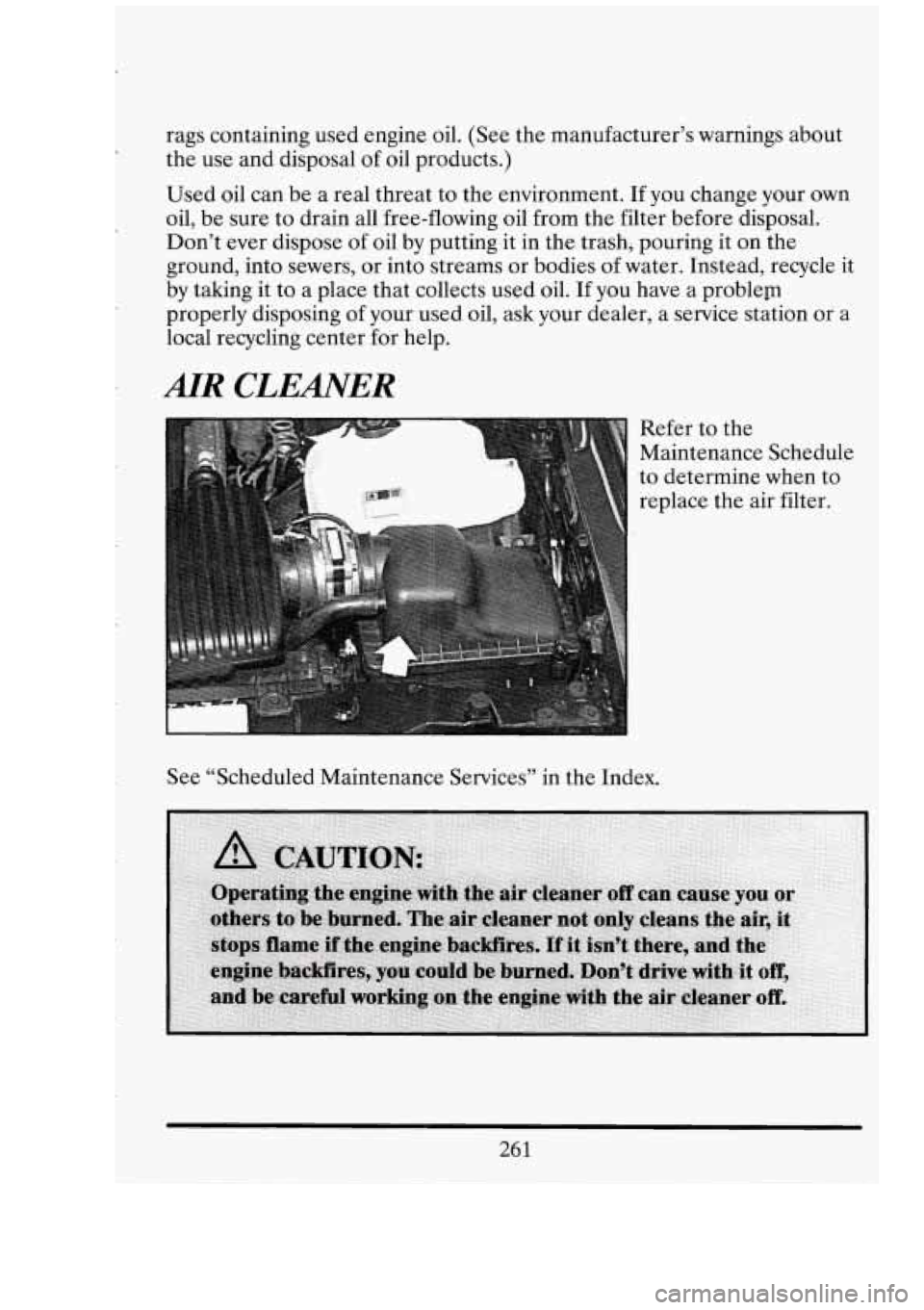
rags containing used engine oil. (See the manufacturer’s warnings about
the use and disposal of oil products.)
Used oil can be a real threat to the environment.
If you change your own
oil, be sure to drain all free-flowing oil from the filter before disposal.
Don’t ever dispose of oil by putting.it
in the trash, pouring it on the
ground, into sewers, or into streams or bodies
of water. Instead, recycle it
by taking it to a place that collects used oil. If you have a problem
properly disposing of your used oil, ask your dealer, a service station or a
local recycling center for help.
AIR CLEANER
c- c
See “Scheduled Maintenance Services” in the Index. Refer
to the
Maintenance Schedule
to determine when to
replace the air filter.
261
Page 275 of 398
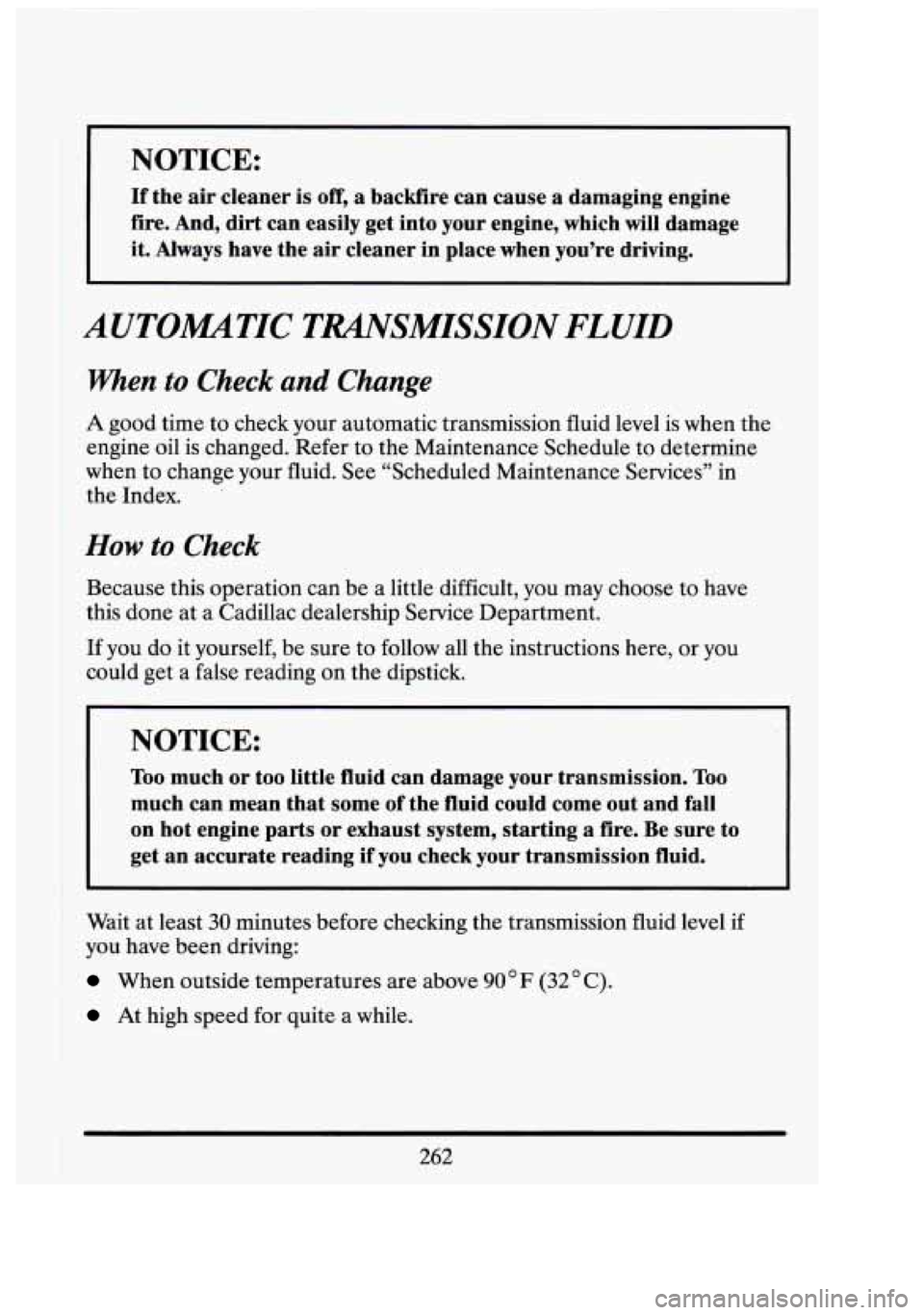
-NOTICE:
If the air cleaner is off, a backfire can cause a damaging engine
fire:And, dirt can easily get into your engine, which will damage
it. Always have the air cleaner in place when you’re driving. I
I AUTOAUTIC .TRANsIMISSION FLUID
‘When to Check and Change
A good time to check your automatic transmission fluid level is when the
engine oil is changed. Refer to the Maintenance Schedule to determine
when to change your fluid. See “Scheduled Maintenance Services” in
the Index.
How to Check
Because this operation can be a little difficult, you may choose to have
this done at .a Cadillac dealership Service Department.
If you do it yourself, be sure to follow all the instructions here, or you
cou.ld get a false reading on the dipstick.
I I Too NOTICE: much or too little fluidcan damage your. transmission. Too
much can mean that some of the fluid could come out and fall
on hot engine parts or exhaust system, starting
a fire. Be sure to
get an accurate reading
if you check your transmission fluid. i
I
Wait at least 30 minutes before checking the transmission fluid level if
you
have been driving:
When outside temperatures are above 90°F (32OC).
At high speed for. quite a while.
tll
il
3‘ I
CI)
262
Page 278 of 398
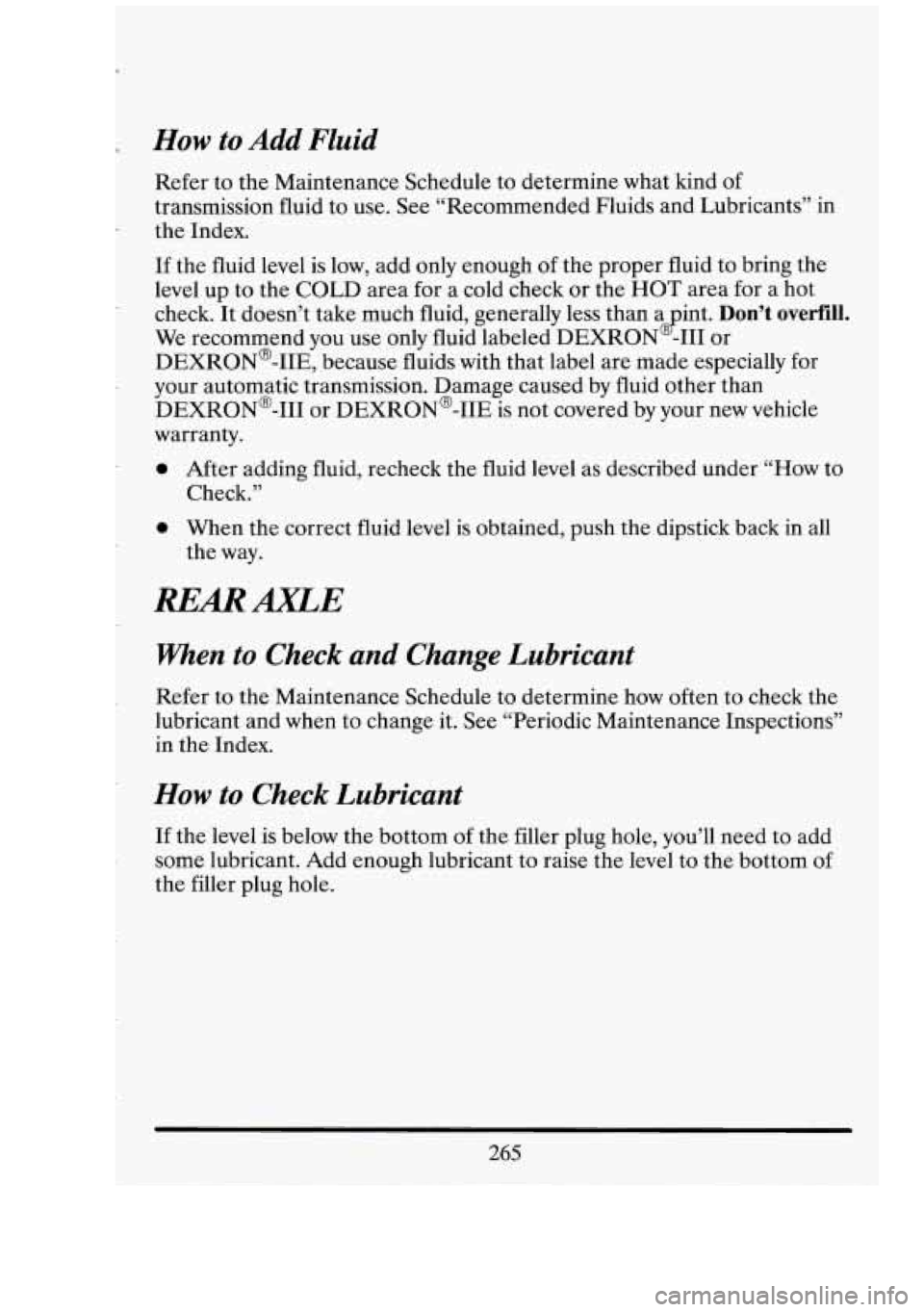
r
How to Add Fluid
Refer to the Maintenance Schedule to determine what kind of
transmission fluid to use. See “Recommended Fluids and Lubricants” in
the Index.
If the fluid level is low, add only enough of the proper fluid to bring the
level up to the COLD area for a cold check
or the HOT area for a hot
check. It doesn’t take much fluid, generally less than a int.
Don’t overfill.
We recommend you use only fluid labeled DEXRON -111 or
DEXRON@-IIE, because fluids with that label are made especially for
your automatic transmission. Damage caused by fluid other than
DEXRON@-I11 or DEXRON@-IIE is not covered by your new vehicle
warranty. 8
0 After adding fluid, recheck the fluid level as described under “HOW to
0 When the correct fluid level is obtained, push the dipstick back in all
Check.”
the way.
REARAXLE
When to Check and Change Lubricant
Refer to the Maintenance Schedule to determine how often to check the
lubricant and when to change it. See “Periodic Maintenance Inspections”
in the Index.
How to Check Lubricant
If the level is below the bottom of the filler plug hole, you’ll need to add
some lubricant. Add enough lubricant to raise the
level to the bottom of
the filler plug hole.
265